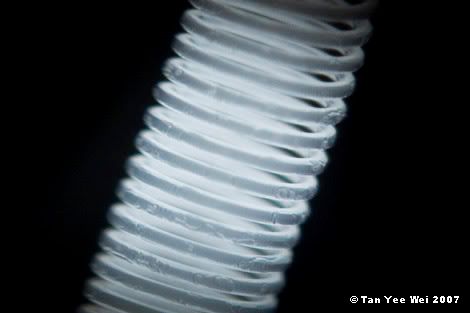A halogen bulb's tungsten filament
I’ve been pimped by Politikus under the Thinking Blogger Award. Supposedly my blog is thought provoking. That's a good start; in a few years my plan to take over the world will be fully in place.
I’ll address that [tag] in a few days. Meanwhile, images...

Click here for large size image
The filament is approximately 3 mm in height and has 19.5 coils
Jupiter-9 85 mm lens reverse mounted on Panasonic PZ30
Ever since acquiring the knowledge of microscopy, I have wanted to get a photograph of the filament in an operating halogen bulb. However, no camera can ever hope to achieve the preposterously short exposure times or sub-micron aperture sizes required to correctly expose the live coil. The only realistic alternative would be the use of some sort of high density filter to remove as much energy as possible, hence making the existing camera usable in this context.

Click here for large size image.
Defects and surface irregularities in the tungsten filament are visible on the bottom half of the coils. The 19.5 coils distributed over 3 mm means that the coil spacing is 0.15 mm. The gap between coils is about the diameter of the filamen, thus the filamen diameter is approximately 0.08 mm.
Super-Takumar 50 mm lens reverse mounted on Panasonic PZ30
With not even one neutral-density filter, much less a stack of them, I made do with a pair of polarizers. A pair of ideal polarizers would block half the light from passing when the polarizers are aligned in parallel, and block all light when aligned perpendicularly. Effectively, I had a variable-density filter with a factor ranging from 2 to slightly less than infinity.

Click here for large size image
A closer view of the preceding image
The use of variable-density filtration has its benefits. The polarizer can be rotated to give a suitable degree of contrast to permit manual focusing. With that done, the shutter button is depressed halfway to lock the aperture and the histogram shows the final image’s brightness distribution. The polarizer can then be rotated to optimise the brightness distribution.

Click here for 100% crop image
The thickness variations on the filament is approximately 1/15 the filament diameter (0.08 mm). Thus the bumps and gaps on the filament are approximately 0.005 mm or 50 microns in scale.
A closer view of the preceding image
Colour is not relevant in these photographs as the entire filament emits black-body radiation corresponding to 3000 K. Any colour seen in these images are the result of chromatic aberrations and white-balance tweaks.

A 100% crop of the preceding image
I’ll address that [tag] in a few days. Meanwhile, images...

Click here for large size image
The filament is approximately 3 mm in height and has 19.5 coils
Jupiter-9 85 mm lens reverse mounted on Panasonic PZ30
Ever since acquiring the knowledge of microscopy, I have wanted to get a photograph of the filament in an operating halogen bulb. However, no camera can ever hope to achieve the preposterously short exposure times or sub-micron aperture sizes required to correctly expose the live coil. The only realistic alternative would be the use of some sort of high density filter to remove as much energy as possible, hence making the existing camera usable in this context.

Click here for large size image.
Defects and surface irregularities in the tungsten filament are visible on the bottom half of the coils. The 19.5 coils distributed over 3 mm means that the coil spacing is 0.15 mm. The gap between coils is about the diameter of the filamen, thus the filamen diameter is approximately 0.08 mm.
Super-Takumar 50 mm lens reverse mounted on Panasonic PZ30
With not even one neutral-density filter, much less a stack of them, I made do with a pair of polarizers. A pair of ideal polarizers would block half the light from passing when the polarizers are aligned in parallel, and block all light when aligned perpendicularly. Effectively, I had a variable-density filter with a factor ranging from 2 to slightly less than infinity.

Click here for large size image
A closer view of the preceding image
The use of variable-density filtration has its benefits. The polarizer can be rotated to give a suitable degree of contrast to permit manual focusing. With that done, the shutter button is depressed halfway to lock the aperture and the histogram shows the final image’s brightness distribution. The polarizer can then be rotated to optimise the brightness distribution.

Click here for 100% crop image
The thickness variations on the filament is approximately 1/15 the filament diameter (0.08 mm). Thus the bumps and gaps on the filament are approximately 0.005 mm or 50 microns in scale.
A closer view of the preceding image
Colour is not relevant in these photographs as the entire filament emits black-body radiation corresponding to 3000 K. Any colour seen in these images are the result of chromatic aberrations and white-balance tweaks.

A 100% crop of the preceding image
Labels: applied science, microscopy, photographic equipment, photography

<< Home